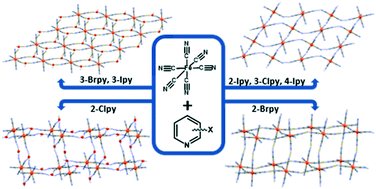The effect of halogen bonding on protonated hexacyanoferrate networks in hexacyanoferrates of halogenopyridines†
Abstract
In order to examine the possibility of controlling formation of hydrogen bonded hexacyanoferrous networks through combination of hydrogen and halogen bonding, seven new crystalline compounds were obtained by reacting hexacyanoferrous acid (H4[Fe(CN)6]) with seven halogenopyridines. The (protonated) halogenopyridines were present in all seven obtained solids, and the extent in which they participate in halogen bonding varied with the halogen atom (Cl, Br and I) and the geometry of the halogenopyridines (o-, m- or p-). Iodopyridines have been found to always form halogen bonds with the cyano groups of the anions, while neither chloropyridine used in this study was found to act as a halogen bond donor. Of the prepared solids, four comprise hydrogen bonded hexacyanoferrate networks achieved by direct binding of H2[Fe(CN)6]2− and H3[Fe(CN)6]− anions through [Fe–CN⋯H⋯NC–Fe] hydrogen bonds into 2D and 3D networks respectively, two are formed from H2[Fe(CN)6]2− anions bridged by water molecules, and one from [Fe(CN)6]4− anions bridged by H3O+ cations. This variability in hydrogen bonding patterns can be brought into connection with different halogen bonding proclivities of the halopyridinium cations.



 Please wait while we load your content...
Please wait while we load your content...